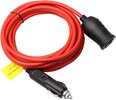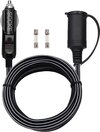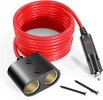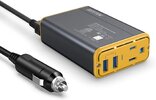carcharger
New Member
I need to have an extension from the car battery to a power inverter in the back seat to charge camera batteries while I am driving.
The built-in car cigar lighter is inop. I am wiring a cigar lighter socket directly to the car battery in the hood. From this socket, I am using a 3 m (10 ft) extension cord from the hood, via the window, that is connected to a power inverter in the back seat of the car.
The problem, whenever I use the extension cord, the charging fluctuates and is totally unreliable/ I tried 3 different extension cords of various brands, all unreliable. If I plug the power inverter directly into the socket at the battery, it works perfectly and powers 120W light bulb with no problem. (As a troubleshooting, I tried to plug the extension cord in another car's working cigar lighter, but the same exact problem presents: with extension cord is fluctuating, power inverter pluged-in directly is reliable)
What is the cause of the problem and how to fix it? Is it a long extension cord or a fuse inside the extension cord or something else?
The built-in car cigar lighter is inop. I am wiring a cigar lighter socket directly to the car battery in the hood. From this socket, I am using a 3 m (10 ft) extension cord from the hood, via the window, that is connected to a power inverter in the back seat of the car.
The problem, whenever I use the extension cord, the charging fluctuates and is totally unreliable/ I tried 3 different extension cords of various brands, all unreliable. If I plug the power inverter directly into the socket at the battery, it works perfectly and powers 120W light bulb with no problem. (As a troubleshooting, I tried to plug the extension cord in another car's working cigar lighter, but the same exact problem presents: with extension cord is fluctuating, power inverter pluged-in directly is reliable)
What is the cause of the problem and how to fix it? Is it a long extension cord or a fuse inside the extension cord or something else?





